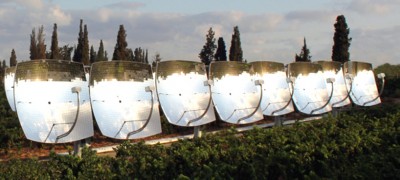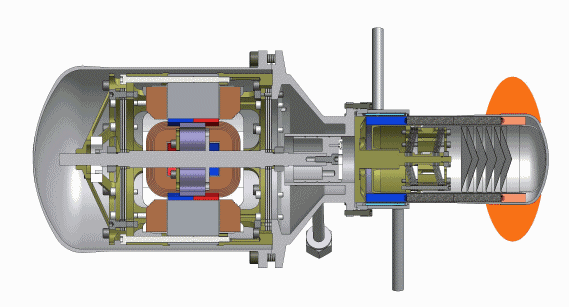There’s only a handfull of parabolic mirror CSP (concentrated solar power) system manufactureres, while the technology is mature and smart. Zenith Solar is the most visible one. It produces the Z20, a dual mirror sun tracking combined PV and heat collector. Because it uses PV and allows taking thermal energy from the focal point it reaches an efficiency of higher than 70%. Efficiency means the usefull energy you gather from the incident solar energy, so the more of it you use (and heat is a large part) the more efficient your system.

The PV cell is a multi junction cell, these have several photovoltaic materials combined so they use a larger part of the spectrum of light. They get multiple suns due to the mirror concentration. They can be put on the roof of buildings for solar airconditioning for instance. In general, the higher the temperature you get from a CSP system, the more usefull and efficient it can be.

Z20 mounted on roof
Another CSP dish company called Stirling Energy systems just went bankrupt. This should not deter people from the idea of CSP using a stirling generator, as bankruptcies are the method of choice to finish of renewables by the fossil fuel dependent credit based financial system. Ask a bank to finance purchase of one of these and they may mysteriously decline, like they have done for wind projects and wave energy projects, but that’s another topic.

The technology is very advanced, and hinges on heat engines (engines running on an external temperature differential) combined with electrical generators. This means the power is generated in the focal point but with more basic technology. One can say that in stirling engines the race was on for the optimal design. Below a dish with the Abengoa Solo V 161 stirling engine, that must have turned out to be more expensive to make than the infinia linear engine below.

You can see the two piston design of the Solo 161. The advantage is that you can use off the shelve generators and there inertia of the movement is preserved.

Below the more innovative linear stirling generator. It is likely to be more efficient. It has one moving part. It sure is more patentable, meaning a more attractive catch for investors and banks. Important to mention the Eneco Whispergen stirling generator for use in gas powerde chp installations. It has a unique way to turn piston movement in rotary movement.

In Stirling engines heat expands air or a gas like helium in a small space (on the right). As it expands it can flow into a larger space where it cools (piston space). There it shrinks and can flow back into the small space. Stirling engines can be hermetically closed and therefore durable, but they have less power than combustion engines that can simply dump the expanded gasses and CO2 in our atmosphere. In the above image you can see the copper coils that generate electricity from a magnet that is connected to the piston. So it’s a linear electro magnetic generator. The two springs store the energy while the movement is reversed.

Infinia sells the Powerdish. A tracking parabolic dish mirror system also using a Stirling heat engine. It produces AC 480 volt output. It is manufactured by former automotive industry producers. Sadly the minimum system is 64 dishes. Nonetheless this system has been in use at scale since 2004.
A look at the generator
Yet anothor producer of dish solar concentrators is CEWA Technologies. It can deliver 30 kW thermal energy at the same price as fossil fuels (probably spread out over 5 years depreciation, which is probably only 20% of the lifespan of the device). CEWA dishes seem to be intended for hot water production for hotels and large buildings, certainly a very usefull and big niche.

Costwise it’s likely multijunction PV systems with use of the heat win the day for dish type CSP systems. This is because of the relatively low cost of materials and low complexity of these systems. Below is an example of a sandwich of photovoltaic materials that each absorb light of part of the spectrum, contrary to normal silicon cells that only use a small part. Multijunction cells can be expensive because they are made in small quantities. One of the problems is to keep the sandwich intact as it is created, because different layers expand at different speed. This problem matches those seen the LED industry. The materials are similar too.

If one classifies the dish CSP products by the method of light to electricity conversion (while for someone wanting to produce pure heat all dishes are similar), there is one technology missing. Its the AMTEC converter. In an AMTEC converter the power is generated by pushing sodium vapour through a barrier towards the colder part of the system. The sodium loses electrons that flow around the circuit. Once the vapour condences it flows back to the hot part.

AMTEC generators have been proposed for deep space missions, running on nuclear heat. Their benefits are thier high reliability and potentially high efficiency (up to 40%). Temperatures necessary are high but easy to achieve in a CSP dish. The cost could be as low as 1$/Watt according to DOE papers. Not the first low cost solution ignored by almost everyone.

